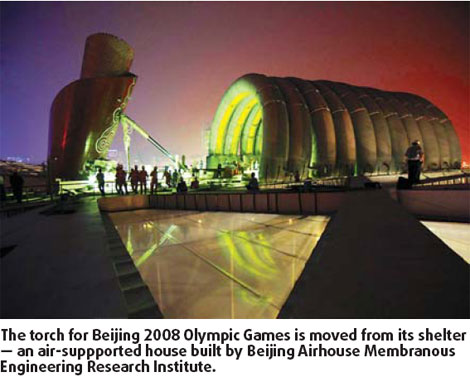


On June 15, an aerial photograph and televised pictures of the top of the Beijing National Stadium, the Bird's Nest, sparked an international guessing game -- what was the "small nest" or house that emerged overnight atop the giant venue?
Light hearted speculation ranged from "Bill Gates' viewing box" to "secret Chinese weather control machine" or "an Olympics UFO hanger".
The answer was unveiled on August 8, the day of the Games opening ceremony: it was a large inflatable shelter for assembling and storing the 31-meter-high and 12-meter-diameter Olympic Torch . The torch suite was 23 meters wide and 15 meters high - a size similar to typical five-floor building in urban China. The 50-plus tons torch had been in the air-supported house for nearly two months.
Tong Wei, general manager of the Beijing Airhouse Membranous Engineering Research Institute, producer of the "small nest", relaxed after it was all over and said he and over 300 employees of his company had experienced nearly 60 days and nights without relaxation, but were really excited.
"All the efforts were worthwhile," says Tong, recalling how his company accomplished the "mission impossible". He emphasized that the success did not only push the company's tech research and development into the fast lane but also consolidated the Airhouse brand as a leader in the membranous structure sector.
It was just 13 days before June 15, when the Olympic torch shelter was scheduled to be finished, that Beijing Airhouse outbid five competitors to be appointed by the Beijing Organizing Committee for Olympic Games to build the membranous structure house.
Usually, designing and building such a giant structure would take several months, especially given the construction base - the sloping roof of the Bird's Nest. In addition, roof is 62 meters tall, and the wind resistance capacity of the air house was expected to reach 23 meters per second, equivalent to a nine-grade wind.
According to Tong, the committee was convinced by Airhouse's long experience with membranous structure building design and construction. The private enterprise was set up in 1991 and successfully serviced the 1999 Kunming World Horticulture Fair, national parade for the 50th-anniversary of the People's Republic of China, and Spring Festival Gala Evening held by China Central Television.
"It seemed to be a 'mission impossible'," says Tong. "We evaluated the risks both in terms of technical and social aspects before contracting to the mission. We designed all the details of the engineering and backup."
Tong, who is also the company's research and development coordinator, evaluated the risks: a 70 percent probability of finishing on deadline, a 20 percent chance of delay due to time problems and the remaining 10 percent chance of unpredictable delays due to circumstances such as weather.
" 'Do it!' I said. I made the decision based on our designing strength and manufacturing capacities."
In addition to in-house design and materials production in Airhouse's plant, a 38-person team was dispatched to the Bird's Nest to assemble the inflatable membrane structure facility.
The house was half-completed on June 13, when a sudden storm, the heaviest one of the summer in Beijing, forced the builder to destroy part of the semi-finished shelter due to water damage.
The company successfully repaired the inflatable house and finished it on time, but with the accident in mind, Tong decided to make further improvements to the airhouse in every possible detail.
He led colleagues in upgrading the design and made another version of the airhouse, which replaced the first one on the night of June 26. "So, what the people saw from June 27 to August 7 was not the initial house. The second had better wind load capacity and stability due to engineering innovation," says Tong, who is a perfectionist in his colleagues' eyes. The improved version cost roughly 250,000 yuan.
Tong says the total cost of the airhouse was between 700,000 to 750,000 yuan. A slim profit could be expected from the project, but Airhouse's value bounce came from its increased technology and brand effect on the market.
"We are not only eyeing the financial benefit, but the significance to our company as well as the field of membranous engineering. It's meaningful to the industry and our company," he notes.
"It's a chance for us to show our capability and boost our brand at home and abroad - that's the point," Tong adds.
(China Daily 10/13/2008 page12)













